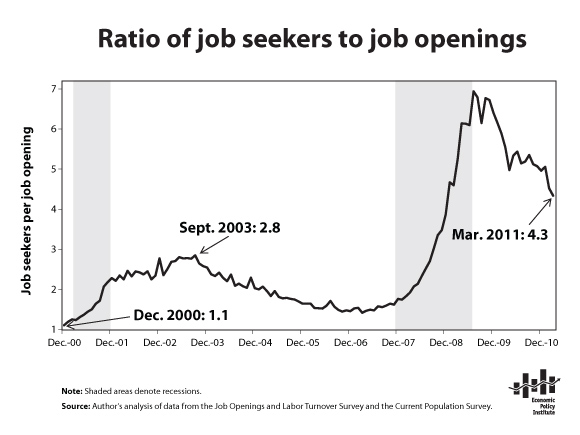This morning, the Bureau of Labor Statistics released its March report from the Job Openings and Labor Turnover Survey (JOLTS), showing that job openings increased by 99,000 in March, though the improvement was largely offset by a downward revision of earlier data by 68,000. Most of the job openings were in professional and business services, education, and health services.
The total number of job openings in March was 3.1 million. The total number of unemployed workers was 13.5 million (unemployment is from the Current Population Survey). The ratio of unemployed workers to job openings was thus 4.3-to-1 in March, an improvement from the revised February ratio of 4.5-to-1. However, March marks two years and three months that the “job seeker’s ratio” has been substantially above 4-to-1. A job seeker’s ratio of 4-to-1 means that for three out of four unemployed workers, there simply are no jobs. The highest this ratio ever got in the early 2000s downturn was 2.8-to-1 in the middle of 2003.

The jobs report released May 6th showed that despite payroll job growth over the last year, the labor force (the employed plus jobless workers who are actively seeking work) is still smaller than it was before the recession started—by around half a million workers. During the same period, the working-age population grew by 6.7 million workers. If the labor force participation rate had held steady over the downturn, there would be millions more workers in the labor force right now, but instead, those would-be workers are on the sidelines. Some have expressed surprise that these missing workers have not yet begun to enter or reenter the labor market in large numbers, given that the labor market has now been adding jobs for more than a year and the job-seekers ratio has improved substantially. What these observers are overlooking is the profound lack of opportunities job seekers still face.
In assessing the dearth of job opportunities, it’s useful to note that layoffs are back down to pre-recession levels. Workers with a job today are no more likely to face a layoff than they were before the recession started—in fact, workers today are a little bit less likely to face a layoff than they were before the recession started. In 2006, the layoff rate (layoffs as a percent of total employment) averaged 1.3%, whereas in the first quarter of 2011, it averaged 1.2%.
Hiring, on the other hand, remains abysmal. The average number of hires per month in the first quarter of 2011 is 27% below the average number of hires per month in 2006, though there are roughly twice as many unemployed workers*. In other words, for job seekers, the labor market remains a nightmarish scene—and anyone scratching their head about why sidelined workers are not yet entering or reentering the labor force en masse in search of jobs is forgetting that.
In an environment like this one, it is important to note that cutting off unemployment insurance benefits or reducing the number of weeks of benefits will not create jobs, but it will make life a lot harder for the three out of four for whom there are no jobs.
Kathryn Edwards and Nick Finio provided research assistance.
*Note, the year 2006 was used for comparison because, although the recession officially began in December 2007, 2006 was the annual low for layoffs and the annual high for hiring.